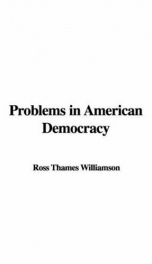Problems in American Democracy

Purchase of this book includes free trial access to www.million-books.com where you can read more than a million books for free. This is an OCR edition with typos. Excerpt from book: CHAPTER III THE DEVELOPMENT OF AMERICAN DEMOCRACY 22. Local versus national spirit. The outbreak of the American Revolution proved that the colonies were so deeply attached to democracy that they were willing to fight for it. But the spirit which animated the Revolution was local, rather than national. The colonial protests which in 1776 reached their climax in the Declaration of Independence, had to do almost entirely with the rights of the colonies as individual states, and with the determination of those states to defend the principle of self-government. The war created thirteen practically independent states, among which the spirit of state sovereignty was much stronger than was the inclination to form an indissoluble union. The Revolution emphasized local and state interests rather than intercolonial cooperation, and however much the colonists appreciated local democracy in 1776, they had yet to learn to think in terms of a national patriotism. A brief review of the attempts at union before 1787 will serve to illustrate this important point. 23. Early attempts at union. The first notable attempt at union was made in 1643, when Massachusetts Bay, Plymouth, Connecticut, and New Haven formed a league, chiefly for the purpose of mutual defense. This league was in force for forty years, and rendered effective service in the Indian wars. In 1754 delegates from seven of the colonies met at Albany and adopted a plan of union proposed by Benjamin Franklin. The plan provided for a colonial army, the control of public lands, legislation affecting the general welfare, and the levying of taxes for intercolonial projects. In America Franklin's plan was regarded with considerable favor, but it was nevergiven serious consideration by the British Parliament. The project fell t... --This text refers to an alternate Paperback edition.
Info about the book
Author:
Series:
Unknown
ISBN:
1414262671
Rating:
4/5 (2)Your rating:
0/5
Languge:
English
Users who have this book
What readers are saying
What do you think? Write your own comment on this book!
write a commentGenre
if you like Problems in American Democracy try:
Other books by this author
Do you want to read a book that interests you? It’s EASY!
Create an account and send a request for reading to other users on the Webpage of the book!


